
Euphorbia is a very large and diverse genus of flowering plants, commonly called spurge, in the family Euphorbiaceae. "Euphorbia" is sometimes used in ordinary English to collectively refer to all members of Euphorbiaceae, not just to members of the genus.
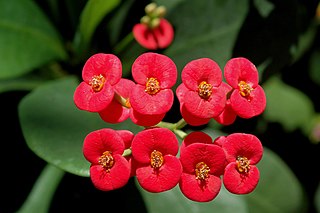
Euphorbia milii, the crown of thorns, Christ plant, or Christ's thorn, is a species of flowering plant in the spurge family Euphorbiaceae, native to Madagascar. The species name commemorates Baron Milius, once Governor of Réunion, who introduced the species to France in 1821.

Euphorbia resinifera, the resin spurge, is a species of spurge native to Morocco, where it occurs on the slopes of the Atlas Mountains. The dried latex of the plant was used in ancient medicine. It contains resiniferatoxin, an extremely potent capsaicin analog tested as an analgesic since 1997.
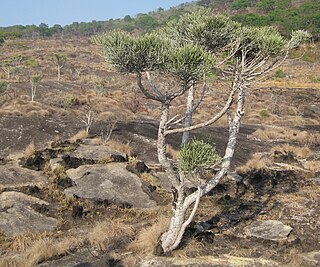
Euphorbia tirucalli is a tree native to Africa that grows in semi-arid tropical climates. A hydrocarbon plant, it produces a poisonous latex that can cause temporary blindness.
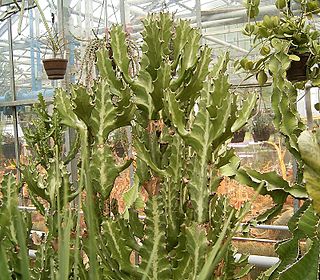
Euphorbia lactea is a species of spurge native to tropical Asia, mainly in India.
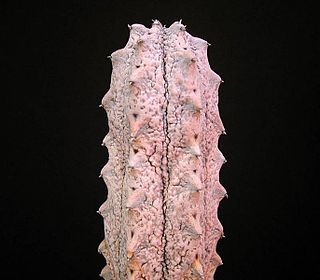
Euphorbia abdelkuri is a species of plant in the family Euphorbiaceae. It is endemic to Abd al Kuri, an island south of Yemen. Its natural habitat is rocky areas. The Latex of the plant is toxic.
Euphorbia alcicornis is a species of plant in the family Euphorbiaceae. It is endemic to Madagascar. Its natural habitat is rocky areas. It is threatened by habitat loss.

Euphorbia arbuscula is a species of plant in the spurge family (Euphorbiaceae). It is endemic to the archipelago of Socotra in Yemen. Its natural habitats are subtropical or tropical dry forests and subtropical or tropical dry shrubland.

Euphorbia canariensis, commonly known as the Canary Island spurge, Hercules club or in Spanish cardón, is a succulent member of the genus Euphorbia and family Euphorbiaceae endemic to the Canary Islands. It is the plant symbol of the island of Gran Canaria.

Euphorbiaceae, the spurge family, is a large family of flowering plants. In English, they are also commonly called euphorbias, which is also the name of the type genus of the family. Most spurges, such as Euphorbia paralias, are herbs, but some, especially in the tropics, are shrubs or trees, such as Hevea brasiliensis. Some, such as Euphorbia canariensis, are succulent and resemble cacti because of convergent evolution. This family has a cosmopolitan global distribution. The greatest diversity of species is in the tropics; however, the Euphorbiaceae also have many species in nontropical areas of all continents except Antarctica.

Euphorbia balsamifera is a flowering plant in the spurge family Euphorbiaceae. It is distributed in the Canary Islands and the western Sahara. It is the vegetable symbol of the island of Lanzarote. Euphorbia adenensis has been treated as a subspecies of this species.

Euphorbia antiquorum, known as antique spurge and "Euphorbia of the Ancients", is a species of succulent plant in the family Euphorbiaceae. It is widespread throughout peninsular India, but its wild origin is obscure. Escaped or naturalized and widely cultivated in neighbouring regions, such as Burma, China, Bangladesh, India, Indonesia, Iran, Malaysia, Myanmar, Pakistan, Thailand, the Philippines, Sri Lanka, and Vietnam, and in many tropical zones worldwide.

Euphorbia aeruginosa is a succulent member of the spurge family native to South Africa. It grows as a small shrub, in sandy soils and in the fractures of rocks sending up multiple spiny blue-green photosynthetic stems. The plant produces yellow cyathia or flowering heads.

Euphorbia tuckeyana is a species of flowering plants of the family Euphorbiaceae. The species is endemic to Cape Verde. The species is named after James Hingston Tuckey. Its local name is tortolho. The plants are used for tanning hides. As most other succulent members of the genus Euphorbia, its trade is regulated under Appendix II of CITES.

Euphorbia anachoreta is a species of flowering plant in the family Euphorbiaceae, endemic to the Fora Islet of the Savage Islands. This species has been considered a Critically Endangered species due to its highly restricted population size. As most other succulent members of the genus Euphorbia, its trade is regulated under Appendix II of CITES.

Euphorbia pedroi is a species of flowering plant in the spurge family endemic to the Arrábida Natural Park in Portugal. It is part of section Aphyllis, a mostly African and Macaronesian clade, being the only member of its section native to Europe. Its binomial name is dedicated to José Gomes Pedro (1915-2010) a Portuguese botanist, who studied the flora and vegetation of Arrábida and Mozambique.

Euphorbia meloformis, called the melon spurge, is a species of flowering plant in the genus Euphorbia, native to the Cape Provinces of South Africa. A succulent, it has gained the Royal Horticultural Society's Award of Garden Merit.
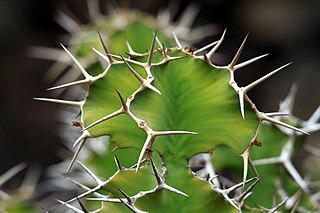
Euphorbia grandicornis, the cow's horn plant, is a succulent plant of the Euphorbiaceae or spurge family. It is native to the KwaZulu-Natal province and the Northern Provinces of South Africa and to Mozambique and Eswatini.
Euphorbia ampliphylla is a succulent rainforest tree of the montane rainforests throughout East Africa and belonging to the Spurge Family (Euphorbiaceae). The branches are each about eight inches in diameter and are succulent and three-winged and pachycaulous. Like most euphorbs, it has milky white sap. The toxicity of many euphorbs is well known, but no specific information is available concerning E. ampliphylla. It is used locally for medical purposes. It is particularly noted for two things: It is the tallest of all known succulent plants, definitely up to 98 feet and indicated on a carefully scaled diagram as reaching 105 feet. It is also the world's only known succulent rainforest tree.
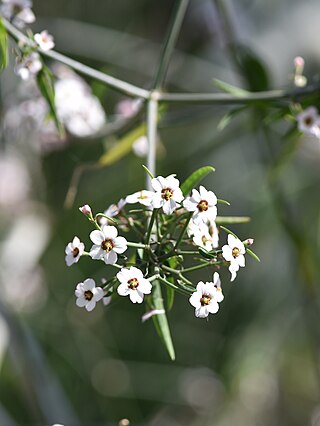
Euphorbia xanti, known as Baja spurge, is a species of flowering plant in the spurge family Euphorbiaceae. It is native to Mexico, occurring in Baja California, Sonora, and Sinaloa. This species is a shrubby succulent, valued in gardening for drought tolerance and its abundant fragrant cyathia with colourful bracts. As most other succulent members of the genus Euphorbia, its trade is regulated under Appendix II of CITES.



















